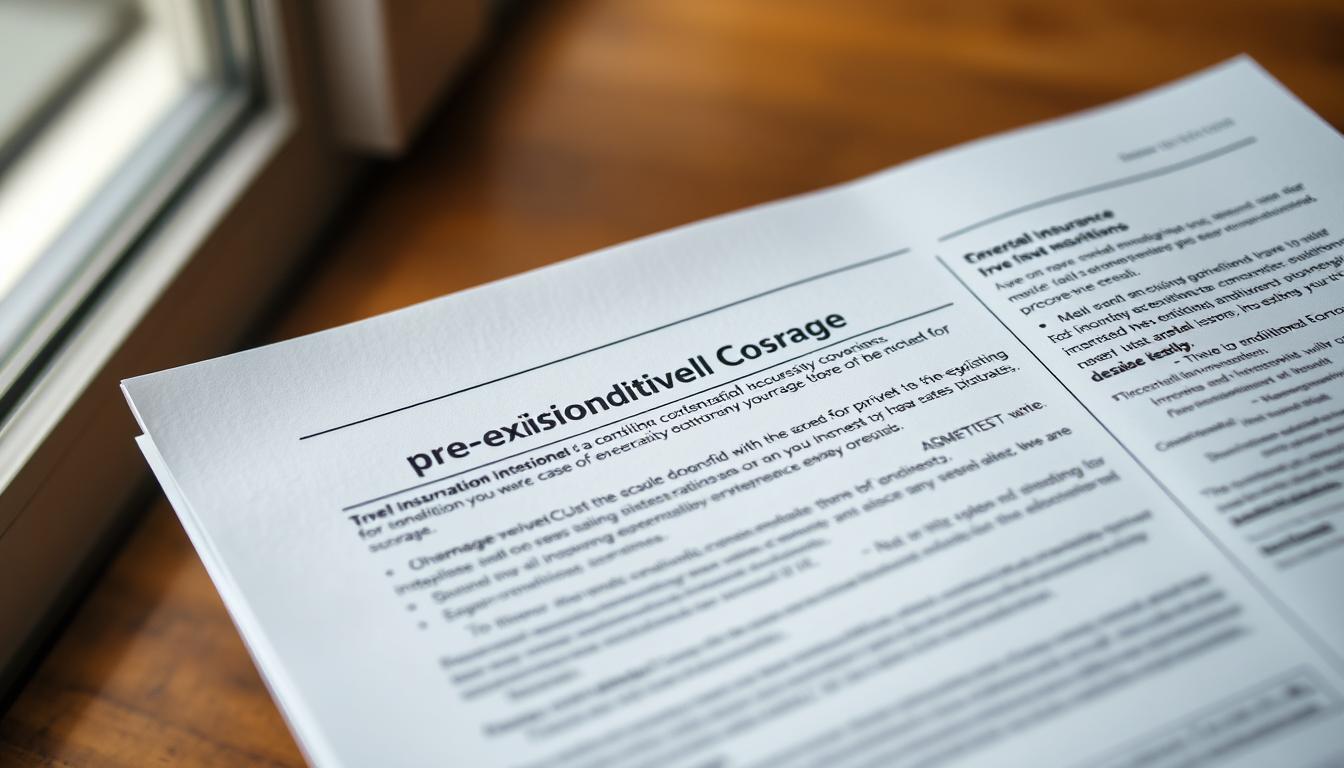Planning a trip but worried about how your medical history might affect your coverage? You’re not alone. Many travelers don’t realize that common health situations—like managing diabetes or recovering from surgery—could impact their protection abroad. Even something as simple as a recent medication change might matter.
Here’s the deal: Insurers often define pre-existing conditions broadly. For instance, Allianz Travel Insurance considers symptoms you’ve discussed with a doctor—even without an official diagnosis—as part of your medical history. A seizure following epilepsy concerns? That could fall under their guidelines.
The good news? Some plans offer exclusion waivers if you buy coverage quickly after booking your trip. But timing and policy details vary wildly. We’ve seen cases where travelers assumed they were covered, only to face surprises later.
Your next move? Grab your policy’s fine print. Look for phrases like “look-back period” or “stability requirements.” These determine whether your situation qualifies for coverage. Up next, we’ll break down how to navigate these rules and what documents you’ll need to stay protected.
Understanding Pre-Existing Conditions in Travel Insurance
Your health background shouldn’t be a mystery when protecting your journeys. Let’s break down how insurers define medical situations that might affect your coverage—and why these details matter.
What Counts as a Pre-Existing Condition?
Insurers typically consider any treated or symptomatic medical issue within 60-180 days before buying a plan as pre-existing. This “look-back period” varies by provider. For example:
| Provider | Look-Back Window | Example |
|---|---|---|
| Allianz | 120 days | Ongoing back pain treatment |
| John Hancock | 180 days | Adjusting blood pressure meds |
| Travelex | 60 days | Recent asthma flare-up |
Everyday Scenarios Explained
Imagine you’ve managed epilepsy for years but haven’t needed medication adjustments recently. Many plans would still classify this as pre-existing. Even undiagnosed symptoms matter—Allianz once denied a claim because a traveler mentioned dizziness to their doctor three months prior.
Here’s the key: Insurers check your medical timeline differently. Some focus on treatment dates, others on symptom onset. Always review your policy’s stability requirements—most require no changes in treatment 60-180 days before departure.
The Role of Exclusion Waivers in Travel Insurance
Navigating coverage options can feel overwhelming when managing health concerns. That’s where exclusion waivers step in—they’re game-changers for travelers seeking peace of mind.
What is a Pre-Existing Condition Exclusion Waiver?
This special provision stops insurers from digging into recent medical history during claims. Imagine your arthritis acts up during a hiking trip. With a waiver, you could still get reimbursed for treatment costs if you met stability requirements beforehand.
Most providers offer this automatically when you buy plans within 10-21 days of initial trip payments. No extra fees apply if you qualify. The key? Your medical situation must remain unchanged during the “qualify pre-existing medical” window specified by your policy.
Benefits of Obtaining an Exclusion Waiver
First, it simplifies the claims process. Instead of proving your condition was stable, the waiver skips that scrutiny. We’ve seen clients avoid denied claims for heart-related emergencies this way.
Second, it covers scenarios insurers might otherwise exclude. A sudden asthma attack mid-flight? If you secured a waiver and followed protocol, you’re protected. Always confirm timelines—missing purchase deadlines voids this advantage.
Finally, it lets you focus on experiences rather than paperwork. While not all situations qualify, those that do gain stronger coverage without jumping through extra hoops later.
Travel Insurance for Pre-Existing Conditions: Qualifying Requirements
Locking in coverage requires perfect timing—and knowing the rules of the game. Let’s explore how to meet eligibility standards while keeping your adventure plans secure.
Time-Sensitive Purchase Windows and Non-Refundable Costs
Most insurance companies set strict deadlines. You’ll typically need to get coverage within 14-21 days of your first trip deposit. Miss this window? You might lose access to waiver options.
Here’s why timing matters: Policies often require insuring 100% of non-refundable costs. That means flights, hotels, and prepaid tours. Partial coverage could disqualify you from certain benefits.
| Provider | Purchase Window | Deposit Required |
|---|---|---|
| Allianz | 14 days | Full trip cost |
| John Hancock | 21 days | Initial deposit |
| Travelex | 15 days | 50% of total |
Medical Fitness and Eligibility Criteria
Being medically able to travel when buying your plan is crucial. If your health changes after purchase, some protections might still apply—but only if you met stability requirements initially.
Always check age limits and stability periods. One client nearly lost coverage because their insurance company required 60 symptom-free days pre-trip. Others needed doctor confirmation of fitness to travel.
Pro tip: Compare multiple plans side-by-side. Some companies offer more flexible timelines or lower deposit requirements. Set calendar reminders for key dates to avoid missing deadlines.
Essential Documents and Medical Assessments
Organizing your paperwork might not be exciting, but it’s your safety net abroad. Let’s unpack what you’ll need to gather—and why each piece matters for your protection.

Physician’s Statement and Other Required Documentation
Start with a signed letter from your doctor confirming you’re fit for travel. This isn’t just a formality—insurers often require it to process claims related to ongoing health needs. You’ll also want:
- Itemized medical bills from the past 6 months
- Prescription records showing dosage stability
- Receipts for recent treatments or devices
Why does this matter? One client’s claim for a hiking-related injury was denied because their physician’s note lacked specific activity clearance. Complete documentation turns “maybe” into “covered.”
Pro tip: Contact your doctor’s office 4-6 weeks before departure. This gives time for corrections if forms need updates. Store digital copies in cloud storage and email them to your travel companion—physical papers can get lost.
Unsure what your policy requires? Ask your care team direct questions like: “Does this letter address stability periods?” or “Should I include vaccine records?” Clear communication now prevents headaches later.
Coverage Limitations and Policy Exclusions
Not every medical situation gets the green light from providers—even with an exclusion waiver. Policies often contain specific carve-outs that could leave you unprotected if overlooked. Let’s unpack where coverage gaps commonly hide.
Conditions Typically Excluded from Coverage
Many plans exclude:
- Chronic cognitive disorders (like Alzheimer’s)
- Mental health treatments (including anxiety therapy)
- Routine pregnancy care without complications
Why these exclusions? Insurers view them as higher-risk scenarios. A client once had a claim denied for panic attacks during a cruise—their policy classified anxiety disorders as ineligible.
Understanding Policy Wording and Exceptions
Phrases like “acute onset” or “stable chronic condition” carry weight. One traveler assumed their controlled diabetes was covered, but the policy required no medication changes for 90 days pre-trip. They missed this detail and faced out-of-pocket costs.
Watch for limitations tied to:
- Age restrictions on certain treatments
- Geographic coverage zones
- Pre-departure health changes at home
Always cross-reference your medical history with the provider’s exclusion list. Better yet—ask them to email you a written confirmation of coverage for peace of mind.
Comparing Top Providers and Policies
Choosing the right protection starts with knowing your options. Let’s explore how major companies stack up for travelers managing health needs—and what makes each stand out.
Overview of Leading Insurance Companies
Three providers dominate this space:
- Allianz: Best for last-minute trips with 14-day waiver windows
- Travel Guard: Top choice for adventure travelers needing higher coverage caps
- RoamRight: Ideal for those with complex medical histories
| Provider | Pre-Existing Coverage Cap | Waiver Window | AM Best Rating |
|---|---|---|---|
| Allianz | $1M | 14 days | A+ |
| Travel Guard | $500K | 21 days | A |
| RoamRight | $250K | 10 days | A- |
Provider Ratings and Benefit Comparisons
Key differences emerge in four areas:
- Coverage flexibility: RoamRight allows medication changes up to 30 days pre-trip
- Claim speed: Allianz processes 89% of claims within 14 days
- Medical networks: Travel Guard partners with 24/7 telemedicine services
We’ve seen clients benefit most when matching their specific needs to these strengths. One family avoided $12K in costs by choosing RoamRight’s longer stability period for diabetes management.
Pro tip: Always check if your policy requires trip cancellation due to health changes at home versus abroad. This distinction impacts coverage more than many realize.
Tips for Buying the Best Pre-Existing Condition Travel Insurance
Securing the right protection for your health needs doesn’t have to break the bank or confuse you. Let’s explore practical strategies to lock in robust coverage while steering clear of common traps.
Maximizing Coverage Without Added Costs
Act fast: Purchase your plan within 14 days of your first trip deposit. This simple step often unlocks exclusion waivers at no extra charge. Need to cover a family? Group plans might offer better rates than individual policies.
Always insure 100% of non-refundable costs. Partial coverage could void key benefits. Check this comparison of major providers:
| Company | Waiver Deadline | Deposit Coverage | Extra Perks |
|---|---|---|---|
| Global Shield | 10 days | Full trip cost | Free telehealth visits |
| SafeJourney | 21 days | Non-refundables only | Baggage delay cash |
| HealthGuard | 14 days | Minimum $500 | Prescription replacement |
Avoiding Common Pitfalls and Misunderstandings
Read stability requirements carefully. Many policies demand no medication changes 60-90 days pre-trip. One client missed this rule by adjusting allergy meds 45 days before departure—their claim was denied.
Three quick tips:
- Ask providers to email confirmation of your covered conditions
- Compare “look-back period” lengths across 3+ companies
- Document all pre-departure health checkups
Remember: Cheapest isn’t always best. A slightly pricier plan with clear pre-existing medical coverage often saves money long-term. Still unsure? Most insurers have 24/7 helplines—use them!
Conclusion
Protecting your journeys starts with smart preparation. We’ve seen how crucial timing is—securing coverage within 14-21 days of booking often unlocks waiver benefits and full protection for non-refundable costs. Those exclusion waivers? They’re your golden ticket to simpler claims if health needs arise abroad.
Documentation makes all the difference. Keep doctor’s notes, prescription records, and policy details organized. Compare providers thoroughly—look beyond price to stability requirements and medical networks that match your needs.
Before departure, double-check your plan’s fine print. Confirm coverage caps, treatment timelines, and any age-related rules. One client avoided $8K in expenses by spotting a 90-day medication stability clause they’d overlooked.
Smart moves now mean smoother adventures later. With the right prep, you can explore confidently knowing you’ve built a safety net that travels with you. Here’s to new horizons—covered.


